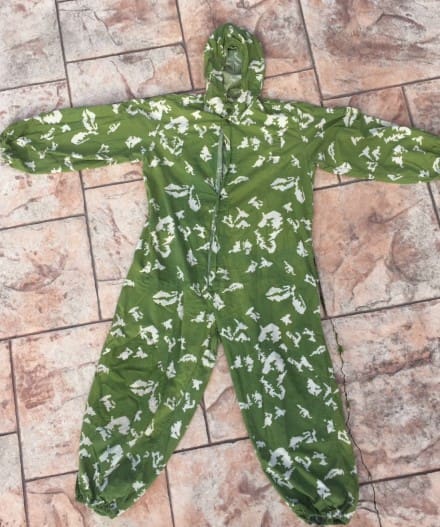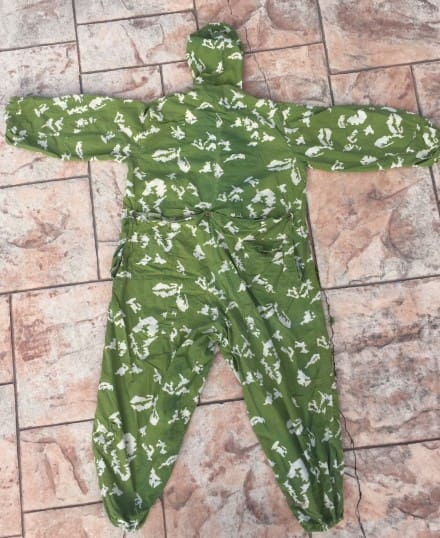Developed in 1968 and first issued to Soviet forces the next year, the Kamuflirovannyy Letniy Maskirovochnyy Kombinezon (KLMK), or in English, Camouflaged Summer Deceptive Coverall was meant to defeat night vision devices.
This lightweight garment is meant to wear over other clothing. It’s oversized design is reversible and incorprates a hood, simple flapped pockets and a drop seat with button flap. The pattern is two-tone (tan and pea green) which offers a rudimentary visual spectrum camouflage.
Interestingly enough, it is still in service and still in production.




Well, it was never a digital camo although sometimes, in Poland for example, it was called “the computer”. Basically, the idea behind the pattern was the very same as US Night Desert Camouflage.
Its not digital, it wasn’t even designed with a computer as far as I know. The jagged edged shapes are actually meant to emulate the rough edges of birch leaves.
From Camopedia.com “a number of the camouflage patterns designed and used in the USSR continued to be worn by the new Russian Armed Forces. Of these, the oldest pattern to see widespread use was the solnechnye zaychiki (sunshine rays) KLMK uniform, which has continued to be worn by some Russian special forces, as well as reservists, Engineer & Cossack units of the Russian Army. The contemporary term for this pattern is berezhka (birch) or serebryanyi list (silver leaf)”
This design is also in fact a simplified version of a pattern that first entered service in 1944: “Entering service later in the war (1944) was the tritsvetnyi makirovochnyi kamuflirovannyi kostium or TTsMKK uniform, printed in a unique three-color disruptive camouflage. The overlapping pattern of dark green and foliage green on a yellow-tan base incorporated a ‘stair step’ concept that would classify many Soviet designs for years to come.”
More details can be found in the “Russia” and “USSR” sections on camopedia.com, and this information has also been re-checked and re-verified and re-confirmed a number of times over the years since the collapse of the Soviet Union and the resultant access to previously unavailable info.
Wasn’t that uniform used in the movie Red Dawn?
http://www.imfdb.org/images/1/17/RedDawnPistolA.jpg
Yes, it was used in “Red Dawn” (1980’s version). The film costumes were made from reproduction printed light fabric, and some showed up in surplus stores after filming.
Love it!
I appreciate the donation.
Unlike the U.S. the Russians don’t just throw good things out when they’ve done something marginally better. They’re still using tank suits from WW2 with the same design. TOZ-43. I’m mad that we abandoned ERDL Green camouflage and OG-107 Jungle uniforms that perform amazingly still today.
Some things do indeed last, but… I’m not so sure that the ERDL pattern was really that good, compared to some of the current offerings like CADPAT. ERDL worked great so long as you weren’t moving, but once you started, you stood out. Or, so went my experiences with it. Woodland wasn’t much better, in that regard.
It also needs to be pointed out that “OG-107” covers the whole range of OD uniforms that we wore through the ’60s and ’70s, not just the Jungles, which were actually entitled “Tropical Combat Uniform”. OG-107 was just the color, a fact that a lot of today’s soldiers are ignorant of. Likewise, there were several different patterns of uniform, and different ERDL color palettes. ERDL came in a brown-dominant version, and a green-dominant, depending on where you were going to be wearing it.
As well, while the OG-107 Jungles were pretty good, they did have their idiosyncracies–The fabric was good for maybe a couple of months of steady use, and then became horribly prone to ripping. Of course, the ones I wore had decades of storage on them by the time I was wearing them, but still…
The design itself wasn’t horrible, but I’d hate to have to try to integrate that top into wearing with modern body armor and web gear. Among other issues…
To be quite honest, though, the Canadian OG green uniforms were something of an improvement, with the heavier taped buttons and heavier cloth.
One does wonder, though, whether or not the current mania for camouflage patterns isn’t taking on something of a heraldric role in military life. If that’s the case, then it won’t be but a couple of generations before the patterns themselves are adjudicated by the Institute of Heraldry
Hmmm, I dig it. I like most of the Ruskie patterns, but the eBay prices are ridiuclous. And the deals I’ve found are negated by extra high shipping cost from the Federation or Albania or wherever else these fell off the back of a truck. Oh well, I guess coyote and wolf will do.
I thought the Germans had a digital pea dot pattern in the mid 1940s, and a plane tree pattern in the late 30s?
I had a set of the “sniper suit” pants and blouse version that US Calvary sold back in the 90’s, right next to the lunchbox sized Magellan GPS NAV 1000s for like $2K. I remember seeing the pattern and instantly wanting to see how effective it worked!
I’ll just leave it here…
http://camopedia.org/index.php?title=USSR
“Tritsvetnyi makirovochnyi kamuflirovannyi kostium” or TTsMKK uniform was developed in 1943-44.
So it is basically a pixelated pattern designed before the pixel.
Interesting article:
https://www.kalashnikov.ru/medialibrary/08e/38_43.pdf
and only text with google translate:
https://translate.google.com/translate?sl=ru&tl=en&js=y&prev=_t&hl=en&ie=UTF-8&u=https%3A%2F%2Fcamouflage4life.livejournal.com%2F1648.html&edit-text=